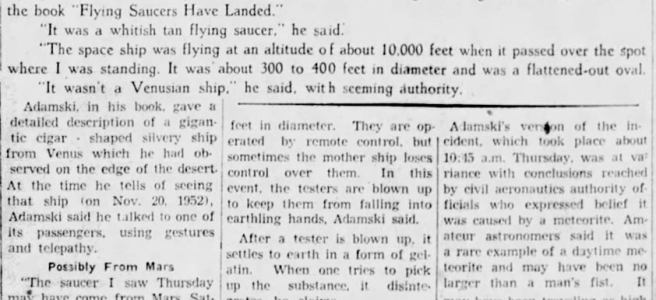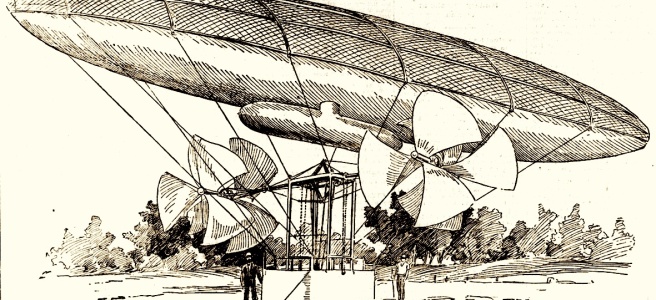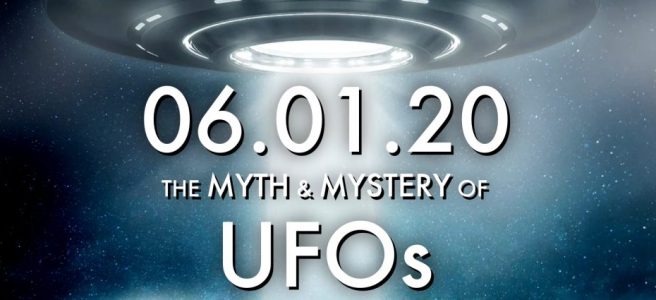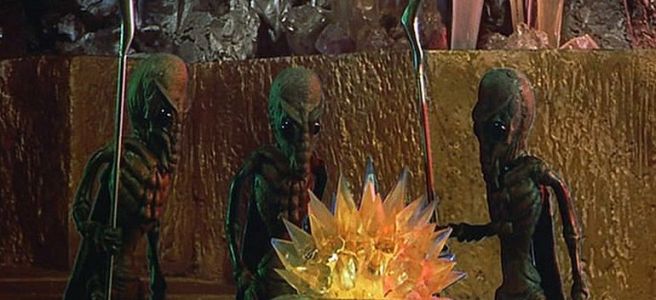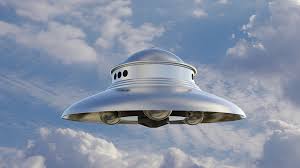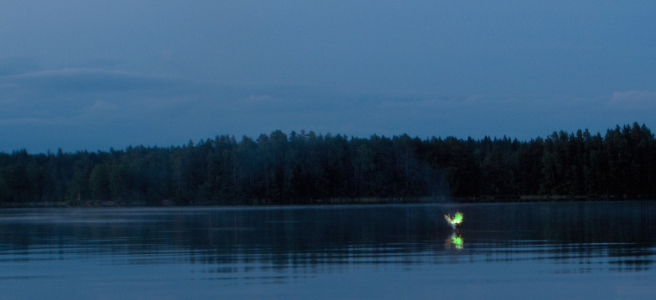A clipping of an article about George Adamski (this post’s featured image) shared by Curt Collins recently got me thinking…
Adamski’s description of a flying saucer’s mother ship’s “tester”, its settling to earth “in a form of gelatin” that disintegrates when someone tries to retrieve it, brings to mind, first, “angel hair”, fibres like wool or nylon reported to fall from UFOs, most famously in Oloron, France, 17 October 1952, fibres that “when rolled up into a ball…rapidly became gelatinous, then sublimed in the air and disappeared” (as Aimé Michel recounts in his The Truth About Flying Saucers (New York: Pyramid, 1967, p. 154). Unlike the substance described by Adamski, these fils de la Vierge were temporarily retrievable before dissolving.
The cognoscenti might also be reminded of a UFO crash retrieval tale avant le lettre. According to The Nebraska Nugget, 6 June 1884 “John W. Ellis and three of his herdsmen and a number of other cowboys …were startled by a terrific whirring noise over their heads, and turning their eyes saw a blazing body falling like a shot to Earth.” When they investigated the crash site, what they found burned with a blinding light and with such heat one of their number suffered serious burns. Once the site cooled, the locals inspected the wreckage, which, following a rain storm and flash flood was reduced to small pools of jelly, which were said to have disappeared, in Jenny Randles’ paraphrase (UFO Retrievals, London: Blandford, 1995), “just like a spoonful of salt dissolving in water” (14). Randles cannily observes “this rather suggests that a spoonful of salt was exactly what the writer expected you to take with this entire story”. Nevertheless, the wreckage’s dissolving rimes with the evanescence of Adamski’s crashed “testers” and that of angel hair, and, given Jung’s alchemically-informed reflections on Flying Saucers, it is not insignificant that the wreckage is said to have disappeared like salt dissolving in water, “salt” being an important term in alchemical discourse…
What relates Adamski’s testers, angel hair, and the ultimate fate of what crashed in Nebraska to ghosts and hauntings is their similarity to ectoplasm (that variously slimy or fibrous substance whereby spirits are thought to manifest or other psi phenomena, e.g., telekinesis, are thought to be accomplished), once uniquely associated with Spiritualism and mediumship but now, in popular culture, associated with ghostly, spiritual phenomena in general. Angel hair and ectoplasm are both described as fibrous (regardless of whether this has to do with the various materials mediums used to hoax their manifestations…), and angel hair, the final residues of testers and airships, and ectoplasm are all gelatinous and evanescent, ectoplasm even, however ironically, extremely light-sensitive. And all are associated with Fortean or paranormal phenomena.
UFOs and ghosts share many other features. In no particular order: both are “transmedium”, UFOs and their occupants reported to pass through solid materials, whether walls or mountains, just like ghosts; both are evanescent, appearing and disappearing unpredictably (which makes them difficult to study under controlled conditions); both have been photographed, recorded, or otherwise instrumentally-registered, but in either case the evidence remains controversial. As Whitley Strieber has suggested and Joshua Cutchin’s forthcoming study maintains, both are relatable to death and the nature of the soul or “consciousness” as the discourse of the day has it. Doubtless, further features could be added (as Jacques Vallée has).
As the ellipses above suggest, my point here is not ufological nor parapsychological, for I make no attempt to separate what might count as “hard data” (more or less demonstrably reliable reports) from the more general discourse (or “stories”) about UFOs and ghosts and spirits. Rather, these analogues appear when these discourses are scrutinized as folklore or mythologies. But the implications for the work that goes on here at Skunkworks are not thereby made clearer. What implications such parallels have for ufology or a more general study of the paranormal I leave for interested parties interested in this way to work out. From the point of view of the ideology-critical speculations that compose some of the writing here, no implications present themselves offhand, and I’m skeptical even a close re-reading of Derrida’s Specters of Marx or brow-furrowing, headache-inducing reflections on the spectrology and hauntology developed therein might bear critical results.
Mythopoetically, these analogues, like those between alien abductions, shamanic initiations, near-death experiences, etc., suggest a complication, expansion or enrichment of a theme that already “has vista” (to borrow Whitman’s words), connotations and significations that, like any work of art, remain open-ended and unpredictable, much like the phenomena that are said to inspire these stories to begin with…
The matter has, at least, worked its way into the on-going composition of Orthoteny, the working title of my poetic treatment of that “mythology of things seen in the skies”. I append a draft of a section from On the Phantom Air Ship Mystery that deals with the Nebraska crash remarked above:

